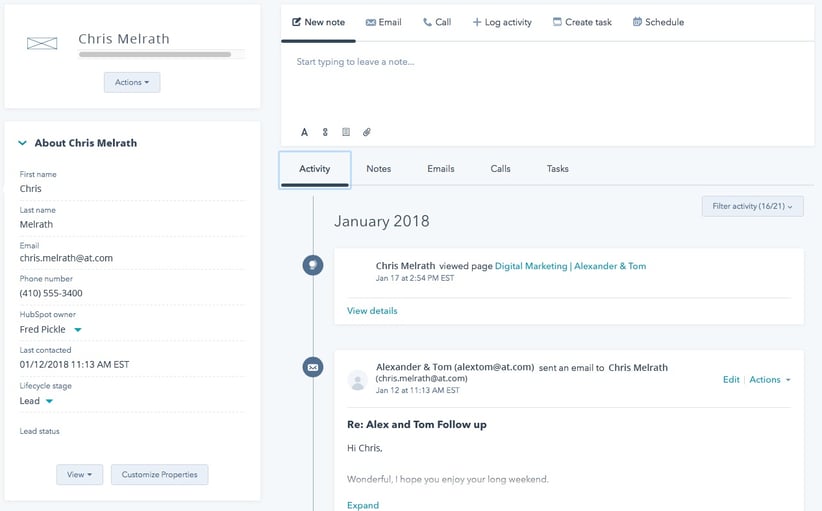CRM stands for customer relationship management, and it refers to software that helps companies track interactions with their future and current customers. Our previous blog post, 4 Benefits of a CRM for Small Business, goes into detail on why your company should utilize a CRM. Now, we’re looking at the 9 most critical features to look for in a CRM.
Simply put, the goal of implementing a CRM is to create a system that your sales and marketing teams can use simultaneously to more efficiently and effectively interact with prospects or customers.
Marketing teams will often use a CRM to ensure that they’re passing qualified leads to their sales team. Salespeople utilize the CRM in a different way, though. They use it to source, communicate, and track prospective customers' interactions over time. Having the entire prospect history in one place increases the sales team’s efficiency and improves their productivity. For instance, salespeople using a CRM won’t have to hunt through their email to remember where a conversation left off.
Before all else, a CRM should be useful to its end users: salespeople, sales managers, marketers, and business leaders. CRMs have a range of benefits, as mentioned in our blog post 4 Benefits of a CRM, but these nine features are must-haves for any business that is aiming to organize their marketing and sales efforts and improve their efficiency.
1 | Contact Management
All CRMs allow salespeople to create contact records and store prospect and customer information in a database. However, the best systems that truly improve efficiency will reduce and streamline contact data entry as much as possible. Judge this feature with ease of use in mind.
2 | Deal Stages
Most customer relationship management systems can be customized to operate in a specific sales process. Whether your company has three deal stages or 15, you should be able to program these levels into the software and attach associated values. It should also be easy to move a deal along the sales process, from one stage to the next. In HubSpot’s CRM, advancing a deal is as simple as dragging and dropping: Make sure the system you are using can be customized to your needs with ease.
3 | Daily Dashboard
Salespeople need visibility into several metrics on a daily basis. Metrics such as their progress to date against quota, how many deals they have in their pipelines at which stages, and what outstanding tasks they need to complete. Similarly, sales managers and leaders need to be able to view these categories for the aggregated sales team. Evaluate this function based on visual appeal and simplicity.
4 | Task Management
A salesperson who must toggle back and forth between several different systems to view and complete their daily tasks is not a happy person (though this is common). CRM systems that include task management capabilities streamline salespeople’s day-to-day work and help them keep on top of their follow up.
5 | Content Repository
According to Docurated’s State of Sales Productivity 2015 study, salespeople spend 31% of their time hunting for or creating content. To cut back on wasted time searching for content, look for a CRM system with an embedded content repository. Look for a system that allows salespeople to save their go-to pieces of collateral in one place. It’s not just collateral either. Writing email copy can be another time suck for a busy salesperson. Look for a system that also allows the user to have customized email templates, so the sales rep is not reinventing the wheel with every new outreach.
6 | Automated Data Capture
One of the primary reasons companies decide to adopt a CRM is to keep better track of customer and prospect touches (emails, calls, etc). But, beware: Many CRM applications require salespeople to copy and paste their email outreach into the system or even upload call recordings.
These extra steps can be maddening for salespeople who are making 50 or 100 calls every single day, and it leaves room for human error. Look for a software that does this step automatically. As an example, HubSpot’s CRM automatically logs calls made and emails sent, and posts them in a timeline-like view on a contact’s record page:

7 | Reporting
A CRM is only as good as the insights it provides. Be sure that your customer relationship management system provides reporting features that make it easy to export and distribute the trends that the system reveals.
8 | Mobile
Sales reps productivity is reported to increase by 15% when they have mobile access to CRM applications. Tying reps to a CRM system that can only be accessed via laptop is bound to annoy them, especially if they’re in a role that requires travel. The majority of CRM systems today allow salespeople to log on to the application from mobile devices such as tablets and smartphones -- make sure the ones you’re considering do as well.
9 | Integration with Marketing Automation
Finally, integration between your marketing and sales platform is crucial. After all, the underlying concept of “customer relationship management” is to provide a complete lifecycle view of each prospect and client. A gap between marketing automation and CRM can lead to lost information and lost opportunities.
Written January 22, 2018 by
Frank Schmidt
"Blogging is the gateway to a realm of new adventures and your customers are ready for an adventure." - Oprah, probably